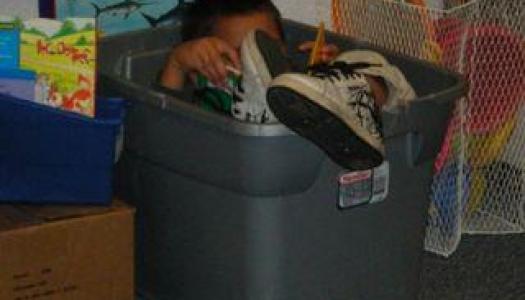Five Levels of Support for Building Stamina
Join Our Community
Access this resource now. Get up to three resources every month for free.
Choose from thousands of articles, lessons, guides, videos, and printables.
 We believe that with scaffolding and support, every student can build stamina and develop behaviors of independence. If they are struggling to do so, we introduce specific tiers of support to scaffold and build success in doable increments.
We believe that with scaffolding and support, every student can build stamina and develop behaviors of independence. If they are struggling to do so, we introduce specific tiers of support to scaffold and build success in doable increments.
Level One—Reflect on Teaching and Classroom Culture
We begin with a reflection on our teaching and classroom culture. Have we built relationships by acting from a warm heart, offering the benefit of the doubt, starting each round with amnesia and a clean slate, and working from a positive presupposition? Building trust and respect by informing the class what they can expect from us, as well as what we expect from them, helps establish a harmonious learning space. A positive teacher/student relationship is key to the success of all other supports.
If stamina isn’t growing at the rate we think students are capable of, we check to see if we have skipped any of the 10 Steps to Teaching and Learning Independence, especially the incorrect and correct modeling portions. These important steps demonstrate the exact behaviors we expect for each Daily 5 task. Being able to see and discuss the correct and incorrect behaviors, and the level of engagement modeled by peers, gives a clear picture of proficiency to all students.
Level Two—Goal Setting
For many students, our teaching and our establishing a positive environment is enough to set them on a course of stamina building. Others need more scaffolds to build stamina.
When first launching Daily 5, we stay out of the way, bringing the round to a close when stamina is broken. If, after a few practices, the same students break stamina first, we move to confer about behavior with them. Conferring about behavior is an addition to Step 8 (Stay Out of the Way) and was added because it becomes clear early on which students are unable to sustain stamina as successfully as their peers. By introducing behavior goals in language from the I-chart—”I will stay in one place,” “I will get started right away”—we zero in on the behavior that is preventing success. We believe these students can be successful when we intercede with supports and instruction.
Level Three—Tools and Choice
Once we have determined that the student needs more support than Level Two provides, we move into offering a variety of tools.
First, we gather tools that will help students develop stamina, such as sand timers of varying lengths and kinesthetic materials students enjoy (play dough, a small bag of pattern blocks, Tangrams, Legos, Silly Putty, or other manipulatives).
If focusing and sustaining reading for more than one or two minutes is difficult, we begin with a conversation on the importance of reading the whole time and give the child a tool—a sand timer or stopwatch—that provides a visual cue for how long to push themselves to read without stopping. First graders may start with a one-minute sand timer, whereas a fifth-grader might start with a three-minute sand timer or stopwatch. We teach that they will read until the sand runs out or they reach the initial time goal on the stopwatch. Then, staying in one spot, they take a brief brain break and use the manipulative. A one-minute sand timer sets the parameter for the brief break. Once the sand runs out, they flip the longer timer and begin reading again, demonstrating the expected behaviors of independence.
Once the student has mastered the initial time goal, we swap out the reading timer for one that is one or two minutes longer. If needed, we identify the timers with an r for read (longer one) and a b for break (shorter one). Depending on the student, we continue with this process, upping the time spent reading as they build stamina until they realize they no longer need tools to maintain behaviors of independence for an entire round. Slowly increasing the length of time the child is reading, interspersed with kinesthetic brain breaks, allows them to build stamina at a pace that works best for them.
Older students may enjoy using sand timers, but we’ve also had success giving them a stopwatch and graph paper. They read until they need a break, mark the time on a stamina graph, taking a one- or two-minute respite with a manipulative, then read again with the stopwatch, graphing their minutes read, all while endeavoring to build longer and stronger reading stamina.
We prefer that children be engaged in their Daily 5 choice for a whole round, and we’ve found that once stamina is developed, they outgrow the need for tools and willingly give them up.
If staying in one place is the challenge, we have students try various seating choices to find the spots that will provide them with greatest success. Do they need a spot with limited distractions? Sitting on the floor with their back against the wall and a limited view into the room may be the ticket to stronger stamina. Does their body need to move or wiggle? A rocking chair, exercise ball, or stability disc will provide an opportunity for movement while staying in one place. A carpet square or yard of fabric can provide a defined space that helps students anchor to one spot. These accommodations honor student needs while helping everyone successfully meet the I-chart expectations.
Level Four—Quick Checks
Simply said, this method injects a quick way to touch base with a child before, after, and between sessions of small-group work or individual conferences. It takes only a few seconds to quietly slip next to them, ask how it’s going, offer a word of encouragement or a bit of support, and then head to our small group or one-on-one destination.
When we provide this support throughout Daily 5, the child is often able to be considerably more successful. This is especially true for students who like or need more attention. If we provide it in a positive way, they may feel less inclined to seek it in a negative way. Level Four support for children is just one of the reasons we no longer sit at a table or on the floor and call students to join us. This just-checking-in-on-my-way-to-my-next-conference strategy respectfully and proactively offers support.
Level Five—Brain and Body Break
Sometimes we enlist the support of colleagues, asking another staff member or two to partner with us. After introducing the student to the staff member, we explain that we have tasks for when they feel an urgent need for a brain and body break.
We may have them deliver some books or a message, or ask to borrow an item. For the first option, we have a few books in a stack with our partner’s name and room number on top. The student’s job is to deliver the books and then return to class, settling back into their Daily 5 choice. For the second, we may send them with a note to the nurse’s office, asking for Band-Aids or a new box of tissues. In the third scenario, we may send them to another room to borrow any number of things.
These activities teach them to pay attention to their body, and provide acceptable opportunities for movement, leading to more successful self-regulation. In addition, these brief, positive interactions with other adults in the school help reframe their image of being a helpful member of the school community, which goes a long way toward building an internal sense of value.
Only the smallest tier of students will require such strategic interventions. By being really reflective, we find we are often able to match students with the support level they require to become successful, thriving members of our literacy community.







